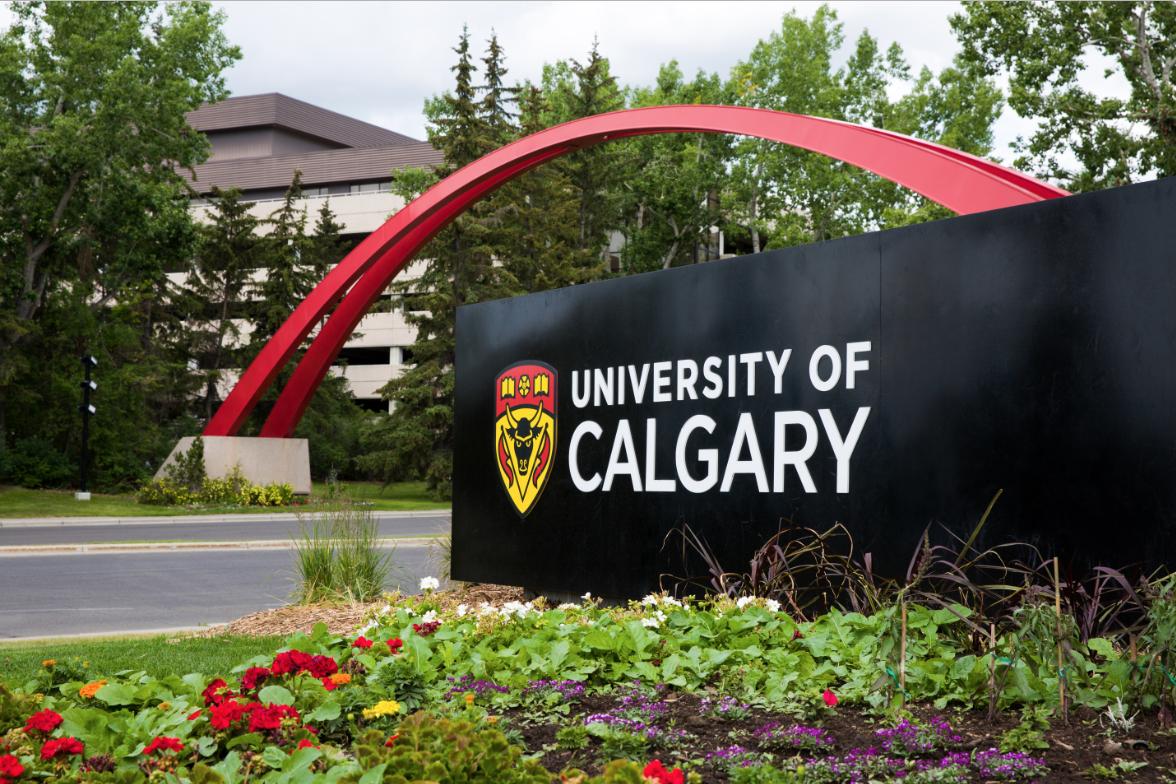On a Friday in the fall of 2010 at 11 p.m., Adriana Tulissi received a phone call from the Muslim chaplain at the University of Calgary. Tulissi manages the Faith and Spirituality Centre, which provides resources and support to anyone on campus for their religious identity, including multi-faith space. The chaplain was in a panic. The student union had cancelled a booking for the Muslim Student Association’s Friday prayers, and now they had nowhere to go. The university has a large population of students from diverse religious backgrounds, which means that the prayer spaces—two rooms separated by a partition smack in the middle of campus on the third floor of the student centre—are usually bustling with activity. It also means that sometimes it is hard to find areas for everyone.
The university’s MacEwan Student Centre has existed since 1987 and houses the student union, food courts and various student services. The third floor has rooms designated for multi-faith use—a large and small prayer room divided with a removable partition, which house about 70 people combined. The nearby washrooms even have an ablution station. While students used the space for individual prayer and booked the rooms for Catholic mass, Buddhist meditation, Sikh simran and other activities, as Tulissi soon learned, the rooms weren’t nearly large enough for the 30,000 people enrolled. On Fridays especially, the space would be bursting at the seams.
The MSA had been booking two floors in the student centre every week to observe Jummah, a special prayer service held in Muslim communities on Fridays. More than 100 students would show up. The group would book the multi-faith room on the third floor for women, while men would pray in an open space on the second floor. They set up a speaker system with a chord that winds down the stairs to the microphone, so that both sides would be able to hear the sermon and prayer.
Even though the MSA had booked the multi-faith rooms and the second-floor space, “sometimes students would be trickling up the stairwell or blocking fire exits,” Tulissi says. That led to complaints. The student union had warned the MSA that they had to address the overcrowding, as per the union’s policies for booking the space, but they simply couldn’t due to the sheer number of students attending the prayers.
On the night Tulissi received the call, the union had been left with no choice but to cancel the MSA’s bookings for the rest of the year, leaving the group to scramble to find another space big enough for their congregation.
“If you’re building a new building, put in a multi-faith space there. To me, it’s just like putting in a bathroom.”
Many campuses across Canada have space dedicated for religious observances. These can range from standalone buildings for multi-faith services to individual rooms. Yet, on many campuses, existing multi-faith centres are not large enough for everyone to use. Adequate space for religious practice on campus can not only help make a university more welcoming, it can go a long way to promoting student well-being with the recognition that their religious identity is a part of who they are.
For many people of faith, practicing religion isn’t optional: it’s part of their identity. Many adherents to faith feel that it gives them a sense of purpose. A recent Pew Research Centre data analysis shows that active participants in faith communities report feeling happier than people who are not regular members of a religious congregation or don’t identify with religion at all. Plus, members of organized religion tend to be more involved in civil society.
Creating multi-faith space on campus helps immerse students more holistically in their formative post-secondary years. Sharon Daloz Parks, senior fellow at the Whidbey Institute in Washington and author of Big Questions, Worthy Dreams: Mentoring Young Adults in Their Search for Meaning, Purpose, and Faith, says campuses are places where students can grow significantly and there should be places where “big questions are present.” Engaging students’ spiritual identities, rather than ignoring them, can help students feel greater belonging and develop their critical thinking skills.
Ideally, a university would have both spaces that can be booked for group programming and other spaces for individual prayer and meditation. “[Individual space] cannot be used as a program space,” says Cody Nielsen, multi-faith coordinator at the University of Guelph, noting that it can create restrictions for students who would like—or need—to pray or reflect on their own time. Nielsen is the founder and executive director of Convergence on Campus, an organization which helps postsecondary campuses develop policies to encourage religious, secular, and spiritual growth.
According to Nielsen, there is a “right” way to introduce multi-faith campus spaces, and it’s important for universities to seek input from faith groups when doing so. Otherwise, the space might not even meet its purpose and the institution is being “reactive to just deal with the problem, not to give the experience,” he says. Nielsen adds that there have been times when universities have designated space without any input and ended up closing them when they weren’t often used. Once spaces are designated for multi-faith use, it’s up to the universities to promote them so students are aware that they exist, Nielsen adds, and to make sure that the spaces are maintained with appropriate items so groups can offer their observances. Tulissi says institutions should be proactive in creating space for faith: “If you’re building a new building, put in a multi-faith space there. To me, it’s just like putting in a bathroom.”
Many campus centres for faith began as Christian spaces, such as at the University of Toronto. Several colleges at U of T’s downtown campus, like Victoria, Emmanuel, Trinity and Knox, had chapels in place by 1900 so students could practice their faith without leaving campus. After the Second World War, students from other religious backgrounds started to become more visible at the university. By the late 1960s, U of T’s Hart House began hosting Hindu festivals as well as Jummah prayers for large numbers of Muslim students. At the turn of the century, U of T students from many different backgrounds began requesting recognition for more religious groups in addition to Christian. That led to a $1.3 million renovation to build the multi-faith centre, which opened in 2007.
“It was part of a recognition that we live in a secular society governed by the rule of law, but what that means is no religious tradition is prioritized over another,” says Richard Chambers, who became the centre’s director in 2008. The facility has multi-use spaces for all kinds of faiths and provides access to chaplains and events. Besides the central building, individual colleges across the campus continue to offer space for multi-faith use. Chambers says most of the spaces are flexible, so furniture can be moved and there’s storage space for yoga mats and prayer rugs, according to individual need.
But Chambers says the change wasn’t just about space—it was just a means to an end: “It’s an expression of a larger commitment to engage students holistically, including their spiritual and religious identities.”

The Monday following the phone call in 2010, Tulissi met with the student union to discuss their concerns. “They were between a rock and hard place,” she says. She created a committee with a few administration members to urgently find a space where the Muslim students could observe Jummah until they found a long-term solution. For about a year, there was a fluctuating schedule where the prayer service was held in varying spots from week to week. By the following fall, they found a spot on the fourth floor of the student centre which could be booked every Friday afternoon for Jummah.
Tulissi then turned her attention towards securing more space for everyone to use. In the summer of 2013, she wrote a lengthy memo to the director of campus planning, quoting research about the benefits of multi-faith spaces and how it fit with U of C’s future plans. The director went to work to find more space.
The following March, the director contacted Tulissi to tell her that an area in the dining centre was being vacated, and it would be renovated for multi-faith purposes. Almost two years and nearly $750,000 later, the Vitruvian Space was opened. The facility has four rooms and can fit about 200 people.
This month will be three years since the Vitruvian Space opened. Though Tulissi says a range of faith groups had been using the multi-faith spaces before the renovation, the addition has meant more groups, including different denominations within religious communities, can now use the spaces for their practices. There’s also room specifically for smudging ceremonies. Besides group bookings, students can come by for individual prayer or meditation. Campus chaplains also host programs in the facility and activities range from religious to spiritual, including mindfulness meditation. Asked how equitably the space is used across faith communities, Tulissi says it’s “fairly reflective” of the campus population.
Yet, despite the added space, Tulissi says there still isn’t enough room for everyone. “I keep a tracking sheet of all the groups we have to turn away because we have no space,” she says, noting that prime booking times occur from the late afternoon all the way to 10 p.m. Tulissi says members of the Sikh community book the Vitruvian Space, along with, among others, about half a dozen Christian groups and two Muslim ones. The MSA’s Jummah prayers still take place on the fourth floor of the student centre to accommodate the large number of students.
Despite campus politics, Tulissi is keeping an eye on the larger picture: ensuring students have adequate space to practice their faith. Once they graduate, they will be navigating a world where different religions and forms of spirituality must co-exist. University is one place they can prepare.


Comments